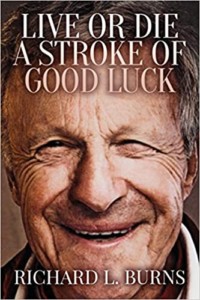Title: Live or Die: A Stroke of Good Luck
Author: Richard L Burns
Publisher: Author Reputation Press LLC
ISBN: 978-1-64961-166-6
Genre: Self-Help
Pages: 115
Reviewed by: Allison Walker
Pacific Book Review
When he is 38 years old, Richard Burns has a stroke which put him in a coma, in the hospital. His doctors tell his wife to begin making funeral arrangements. She writes her husband’s obituary. No one expects Richard to survive – and then, when he does, they tell him to not expect too much from life. A former advertising professional, Burns wakes up in the hospital to a fully different reality. The campaign slogans which used to come so freely are now stopped by his mind’s inability to turn his thoughts into spoken words. Working becomes impossible when he cannot fully control the left side of his body.
Even walking to the bathroom is a process Burns describes as getting hand prints everywhere. His book, Live or Die: A Stroke of Good Luck, about his journey from the brink of death back to the fullness of life, is the inspiring true story of the man who brought you smiley faces on airplanes and men dressed as fruit in underwear commercials. By looking back on his recovery, Burns offers advice to others going through similar experiences.
Live or Die: A Stroke of Good Luck is not only about Burns’ physical journey to recovery but about his mental journey also. He is forced to come to terms with his new body, to become familiar with it all over again, and to accept his new limitations. This recovery process Burns is retrospectively able to break into steps and these steps are the basis for his book. He describes in intimate detail the mood swings and physical debilitation, his friends’ inability to comprehend, and subsequent withdrawal from him, and the betrayal of his employer at his time of greatest need. Burns states that a big part of his recovery is coming to terms with his situation instead of practicing escapism from it. His personal recollection combined with the strategic and purposeful steps he develops during the process makes Live or Die a valuable resource for other victims of stroke.
Burns had a cerebral hemorrhagic stroke, a burst blood vessel which flooded and destroyed parts of his brain. It isn’t until much later in the book, as the story unfolds, that readers learn about the true extend of Burns’ injuries and, most horrifying, the near-constant physical pain and depression which accompanied many of his waking moments on the long, tedious road to recovery. The most heartbreaking symptom Burns describes is the way his personality changes due to the stoke, and the ability of some caregivers to be aware of this and others to be frustrated by it. He recalls he has childish relationships with some people, was frustrated easily, and was easily tricked into a mindset of selfishness. He suffers mood swings and short temper. He was often embarrassed by his actions. Family support that understands this symptom was necessary to the healing process. Burns’ honest and objective look at his own stroke is how Live or Die will help others suffering from similar experiences.
Live or Die: A Stroke of Good Luck is a miraculous story made all the more so by the fact it is true. Burns’ story is truly remarkable and was seen as a medical anomaly when it happened. To go through such a traumatic event is remarkable, but to turn that experience into something which will help others through the same trauma is what makes this book so inspiring. Readers won’t feel so alone after reading Live or Die: A Stroke of Good Luck.


